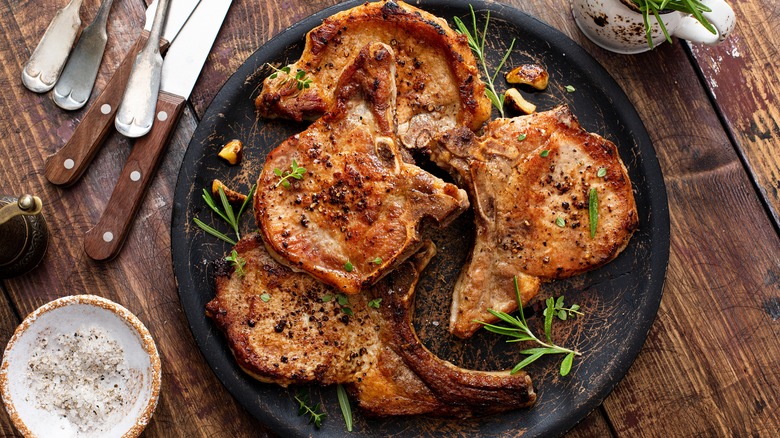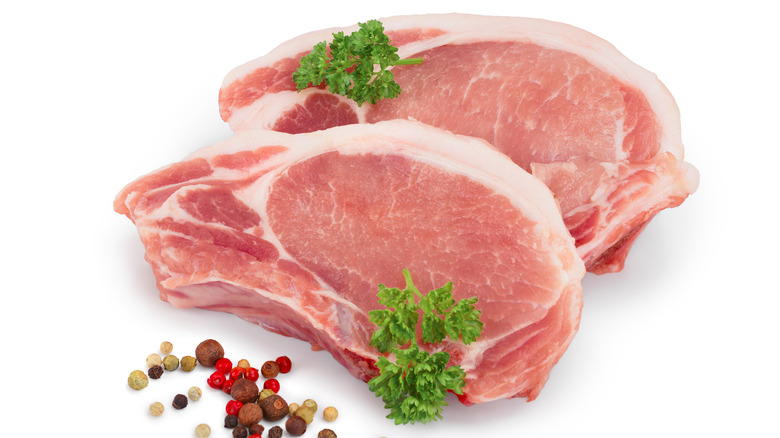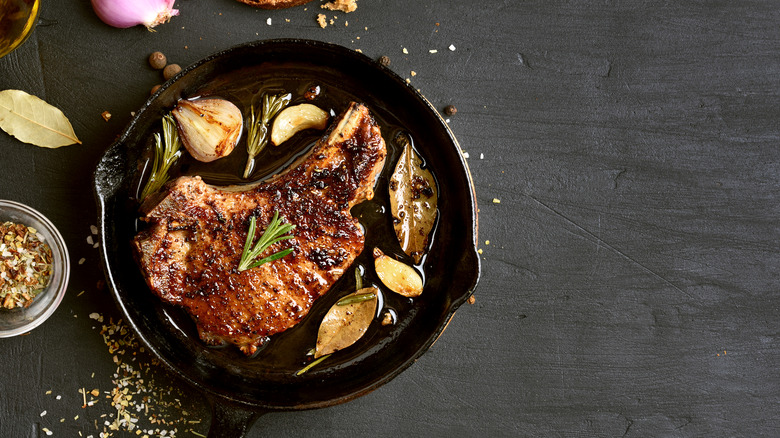The Buttery Baste For More Exciting Pork Chops
One of the greatest challenges for any home cook is to come up with new solutions to the eternal question — what's for dinner? If you need an easy solution to keeping things fresh without having to reinvent the wheel every night though there are few cuts of meat better suited than the humble pork chop.
The National Pork Board claims that pork chops are the most popular cut from the pig. They come from the pigs loin, which extends from its hips all the way to its shoulders. They are also often served with the bone and a band of fat still attached, and this extra fat gives them plenty of flavor. Masterclass says that the loin is also similar to the highly coveted pork tenderloin, meaning that both are highly tender cuts of meat when prepared correctly.
Another great benefit to pork chops is their versatility as they can be baked, grilled, fried, or thrown into the air fryer for a no nonsense dinner. They can also be dressed up with a maple brine, or soaked in a delicious Thai marinade among many any other flavor options that will suit even the pickiest of eaters. Of course, there is another way to create an even more decadent variation on this classic cut of pork, but first let's dive into the anatomy of the pork chop.
Know your pork chops
Not all pork chops are created equal though, and it's important to know your cut of meat before you try to cook with it. According to Kettle Range Meats, because pork chops are taken from such a large section of the pig, there is a ton of variety between different cuts depending on which section of the loin they come from.
Sweet C's Designs says that one of the most popular cuts of pork chops is the boneless loin chop. It has relatively little fat, and doesn't have a bone either. This makes it more challenging to cook with because it can easily dry out if overcooked or cooked improperly. Kettle Range Meats adds that another challenging cut is the Porterhouse Chop. This cut has both sections of the tenderloin and loin which cook at different rates when handled incorrectly. Another temperamental cut is the shoulder pork chop, because it has a higher density of connective tissue, per Sweet C's Designs. That means that the shoulder pork chop is best suited for longer, slower braises.
Porter Road asserts that a great option is the classic bone-in pork chop because it typically has a nice cap of fat, as well as the bone for plenty of flavor. It also comes from the loin, which gives it a tender texture and helps it to cook evenly.
One of the best ways to prepare this delicious cut is like most things — with plenty of butter.
How to butter baste pork chops
Home Chef claims that one of the absolute best ways to prepare pork chops is by butter basting, which is a simple method which involves spooning a hot fat, usually butter, continuously over a cut of meat, per Cook's Illustrated. This helps the meat cook evenly on both sides, while also being infused with the rich flavors of the butter, and whatever aromatics and spices you wish to add to it. Once you master this method, it can also be used to cook flavorful steaks, and even make the best burgers you've ever tasted.
Jess Pryles says that one of the keys is to flip the meat frequently. While most meats are seared on one side, then flipped to sear on the other, because basting is applying heat to both sides, it actually gives you the opportunity to sear one side while caramelizing the other in the slow browning fats of the butter. Simply sear your pork chop, flip it frequently until it's about 30 degrees short of the finished temperature, then add the butter and aromatics. From there, tip the pan at an angle, and quickly spoon the melting butter over the meat and aromatics repeatedly until the meat has finished cooking. The browned butter can also be kept as a sauce to add to the final meat when it's all said and done. Just be careful not to let the butter burn instead of browning for the best flavor.


